Sunday, May 30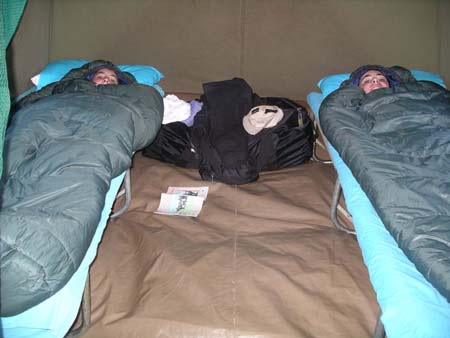
Steve: We left our camp on the rim of Empakaai crater early this morning, setting off to hike north to the village of Naiyobi and on to the Acacia Forest, our next campsite. The morning brought thick fog and a cold drizzle which we have learned is typical of the winter weather in the Empakaai area. Fortunately, things cleared up in time for us to enjoy our hike and the beautiful views of Oldonyo Lengai and the Rift Valley.
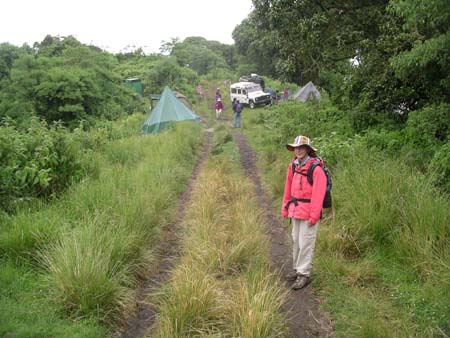 Our
hike took us along a dirt road just to the west of Oldonyo Lengai, called
"The Mountain of God" by the Maasai. Lengai is the only active volcano
in this region, and its last major eruption was in 1983. We encountered many
Maasai boys taking their cattle and goats up into the
Our
hike took us along a dirt road just to the west of Oldonyo Lengai, called
"The Mountain of God" by the Maasai. Lengai is the only active volcano
in this region, and its last major eruption was in 1983. We encountered many
Maasai boys taking their cattle and goats up into the 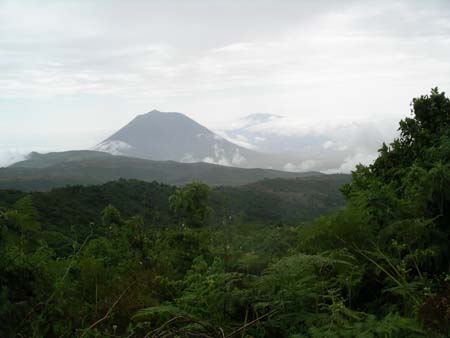 hills
for grazing. We have been consistently amazed with how young many of these
boys are (most start at age eight or nine), especially since this work requires
them to walk long distances and to stay with their animals in the hot
hills
for grazing. We have been consistently amazed with how young many of these
boys are (most start at age eight or nine), especially since this work requires
them to walk long distances and to stay with their animals in the hot 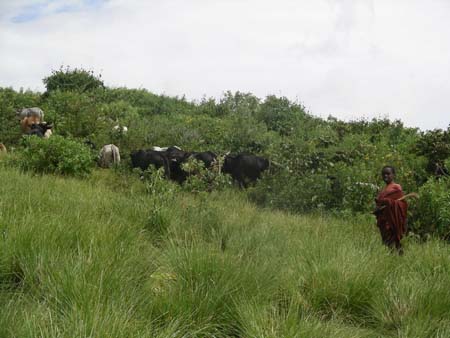 sun
for over eight hours every day.
sun
for over eight hours every day.
During our walk, we spent time speaking with Justin (our Maasai guide) and
Nassibu about the Maasai people. We have found the Maasai to be fascinating,
and of all the ethnic groups that we have met during our travels, we 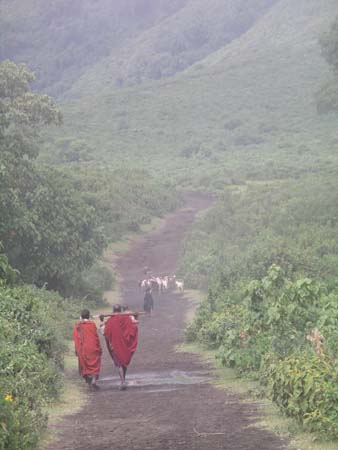 think
that this culture may be the most different from our own.
think
that this culture may be the most different from our own.
The Maasai are herders, and believe that cattle are the most important thin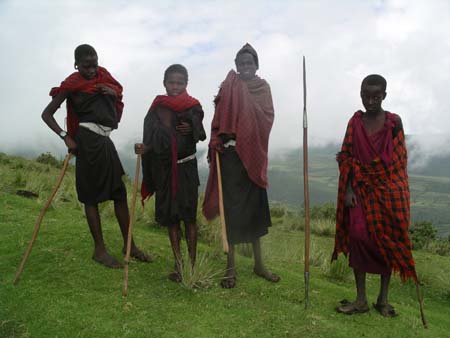 g
in the world. Wealth and status are measured based on the number of cattle
that a family owns, with the wealthiest families owning upwards of 300 cattle
(the average is around 25). The Maasai's primary concerns are having access
to enough grassland and water for their cattle, and many Maasai move frequently
to ensure that their cattle have enough food. The cattle are used primarily
for dairy products, and are only slaughtered during special occasions. The
M
g
in the world. Wealth and status are measured based on the number of cattle
that a family owns, with the wealthiest families owning upwards of 300 cattle
(the average is around 25). The Maasai's primary concerns are having access
to enough grassland and water for their cattle, and many Maasai move frequently
to ensure that their cattle have enough food. The cattle are used primarily
for dairy products, and are only slaughtered during special occasions. The
M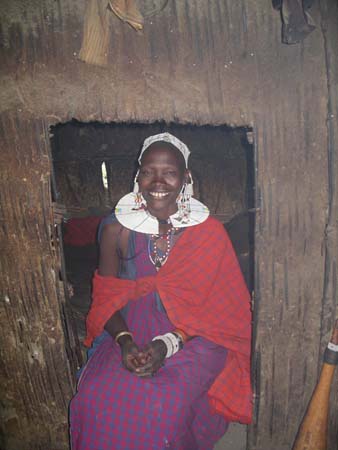 aasai
also raise goats and sheep (for food), and some groups have recently begun
to cultivate corn and other crops to supplement their diets.
aasai
also raise goats and sheep (for food), and some groups have recently begun
to cultivate corn and other crops to supplement their diets.
Nothing illustrated the Maasai's view of cattle better than the conversations
that Justin had with local residents of Naiyobi as we walked through the village
today. 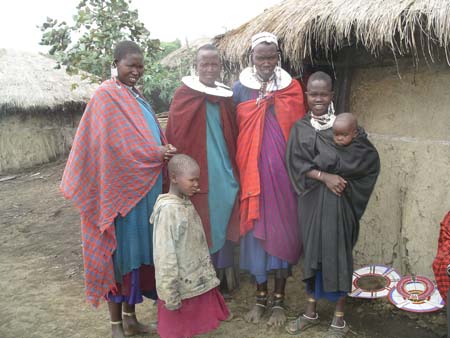 Many
people were curious about who we were, and asked Justin about why we were
in Naiyobi. When he told them that we were a family from America and were
here to visit Tanzania, they immediately asked him who was watching our cattle
at home. When Justin explained that we didn't have any cattle, they told Justin
of how sorry they were for us and that we must be very poor.
Many
people were curious about who we were, and asked Justin about why we were
in Naiyobi. When he told them that we were a family from America and were
here to visit Tanzania, they immediately asked him who was watching our cattle
at home. When Justin explained that we didn't have any cattle, they told Justin
of how sorry they were for us and that we must be very poor. 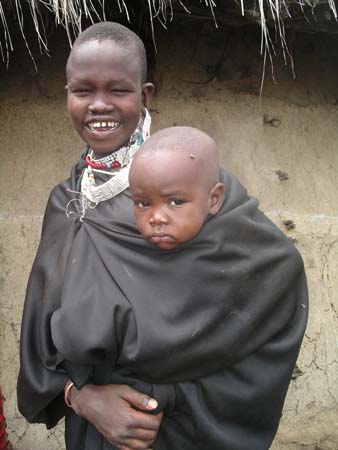
Another good example involved the area where fresh drinking water is collected
after being hauled from streams over five kilometers away. We saw several
cattle drinking there from large troughs, and Justin told us that the Maasai
always let their cattle always drink first. Any remaining water is then made
available to the people of Naioybi. When Katie heard this, her comment was
something to the effect of, "Did I hear that correctly?"
The Maasai are polygamous, with men having as many as 20 wives. The more wives
that a man has, the more respected he is. Men must pay a dowry for each wife,
with the current price in Naiyobi being about seven cattle (we later learned
that the price varies by village and is up to the 15-20 cattle range in the
villages near Lake Natron). M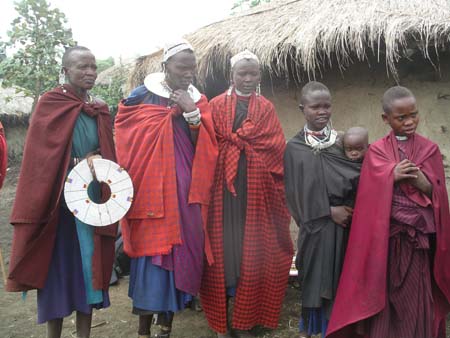 ore
wives mean more children - boys to help take care of the cattle, and girls
that bring dowries to the family to help them become wealthier. Justin explained
that there is a system in place, where a boy's parents find him a wife by
signing a "contract" with a woman from another family. The contract
specifies that a designated future daughter born to the woman will become
the boy's wife. Women typically enter several such contracts, with each boy
taking his place in line (e.g. a boy can have a contract to marry the woman's
third daughter, meaning that he has to wait until she has given birth to three
ore
wives mean more children - boys to help take care of the cattle, and girls
that bring dowries to the family to help them become wealthier. Justin explained
that there is a system in place, where a boy's parents find him a wife by
signing a "contract" with a woman from another family. The contract
specifies that a designated future daughter born to the woman will become
the boy's wife. Women typically enter several such contracts, with each boy
taking his place in line (e.g. a boy can have a contract to marry the woman's
third daughter, meaning that he has to wait until she has given birth to three
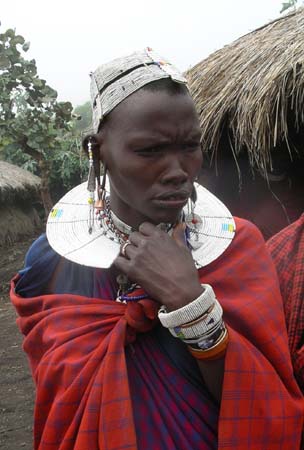 daughters
and then for the third daughter to reach the age of 18). Women wear special
rings given to them when the contracts are established, indicating the marriage
commitments that she has made for her future daughters. It's considered good
for a woman to have many of these rings, because it shows that she has been
selected by several men as being the mother of their future brides.
daughters
and then for the third daughter to reach the age of 18). Women wear special
rings given to them when the contracts are established, indicating the marriage
commitments that she has made for her future daughters. It's considered good
for a woman to have many of these rings, because it shows that she has been
selected by several men as being the mother of their future brides.
Generally, the contract for a boy's first wife is arranged by his father, the second wife is done by his mother, and he must arrange the contracts for all additional wives on his own. If the parents don't have enough cattle to enter such contracts when the boy is very young, then the boy himself goes out usually at age 10 or 11 to secure such a contract for himself.
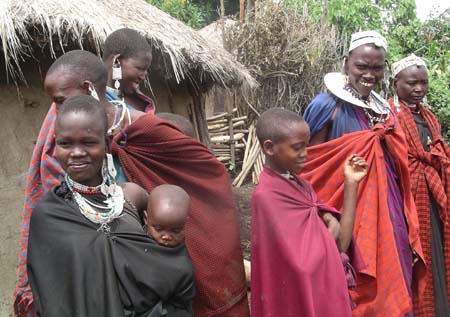 Justin
in fact entered a contract with a family when he was 10, and had to wait for
15 years for his future wife to be born. Justin is now 25, and his future
wife, also from Naiyobi, is 17 months old. Justin told us that he regularly
visits her and brings gifts.
Justin
in fact entered a contract with a family when he was 10, and had to wait for
15 years for his future wife to be born. Justin is now 25, and his future
wife, also from Naiyobi, is 17 months old. Justin told us that he regularly
visits her and brings gifts.
The Maasai have very distinctive dress, some of it corresponding to their
various phases of life. Boys become warriors at around age 20, and begin wearing
the traditional red-plaid cloths and elaborate beaded jewelry. They also begin
carrying spears that traditionally have been used for protecting their cattle.
Just before becoming warriors, the boys are circumcised and begin going through
intense training. During this phase, they wear 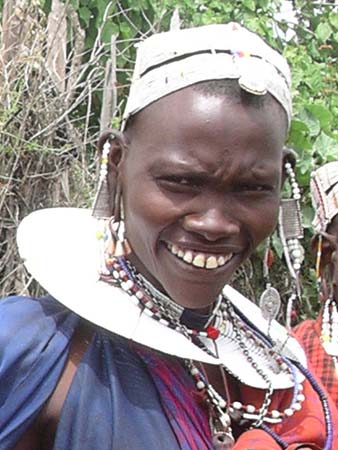 black
cloths under their red coverings.
black
cloths under their red coverings.
After about two hours of hiking, we reached Naiyobi, the Maasai village where
Justin originally grew up. We first paid a visit to Justin's home, where we
were greeted by his mother, father, brother and sister, plus several friends
and other relatives who had gathered. Naiyobi is a small village, home to
about 100 residents. The Maasai homes are round, and are built with branches
that are held together by cow dung and urine. They are small and very dark,
with no windows. Once inside Justin's home, we literally needed a flashlight
to see the sleeping areas and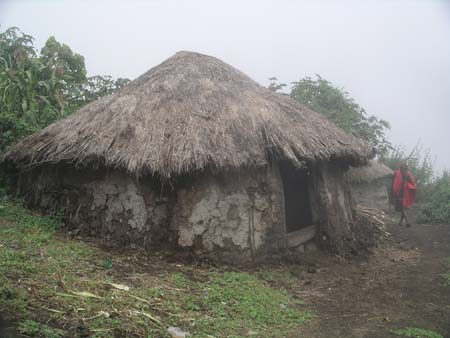 the place where a very small number of cooking supplies are kept. A small
fire is kept burning in he center of the house for heat and cooking. There
are also attached pens to hold the family's young goats.
the place where a very small number of cooking supplies are kept. A small
fire is kept burning in he center of the house for heat and cooking. There
are also attached pens to hold the family's young goats.
Of all the village homes that we have visited during our travels, this house
was one of the smallest and had the fewest number of physical possessions
of anyplace we've seen. Other than a few bowls and mugs and clothes that are
kept in the tiny sleeping areas, there is basically nothing else kept in the
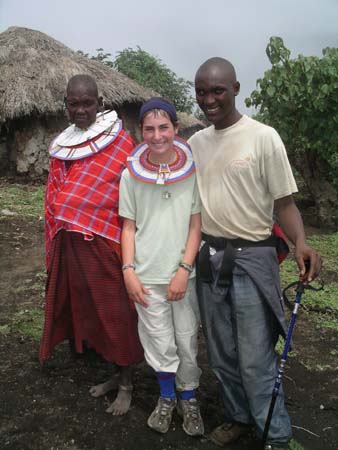 home. Beds are made of dried goat skins. The Maasai's primary possessions
are their cattle, and any money made by selling crafts or corn is normally
immediately used to purchase more animals. Despite their lack of physical
possessions and a standard of living that most Americans could not imagine,
the people we met today appeared genuinely happy in the lives that they lead.
This is very similar to what we have observed with other people in small villages
across the world.
home. Beds are made of dried goat skins. The Maasai's primary possessions
are their cattle, and any money made by selling crafts or corn is normally
immediately used to purchase more animals. Despite their lack of physical
possessions and a standard of living that most Americans could not imagine,
the people we met today appeared genuinely happy in the lives that they lead.
This is very similar to what we have observed with other people in small villages
across the world.
Interestingly, there are some changes that have begun to take place among
the Maasai, with Justin being a good example. Subsequent to becoming a 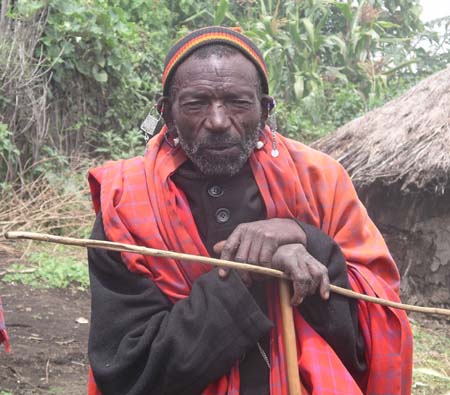 warrior,
Justin decided that he wanted to leave his traditional lifestyle, attend school
beyond the required seven years, and get a job in the tourism industry. This
decision also involved a move from Naiyobi to the city of Arusha, a place
where most villagers visit infrequently, at most. Justin was looking to do
something more than simply take care of the family cattle, and this led to
his decision to abandon the traditional Maasai life. Although more and more
warrior,
Justin decided that he wanted to leave his traditional lifestyle, attend school
beyond the required seven years, and get a job in the tourism industry. This
decision also involved a move from Naiyobi to the city of Arusha, a place
where most villagers visit infrequently, at most. Justin was looking to do
something more than simply take care of the family cattle, and this led to
his decision to abandon the traditional Maasai life. Although more and more
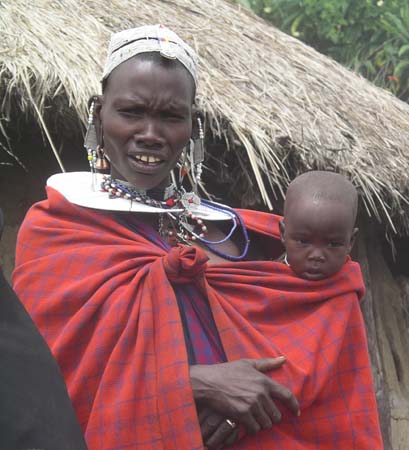 Maasai are looking to make similar changes, the relative lack of jobs makes
this very difficult for most people. Justin told us that many of his peers
left the village for continuing educati
Maasai are looking to make similar changes, the relative lack of jobs makes
this very difficult for most people. Justin told us that many of his peers
left the village for continuing educati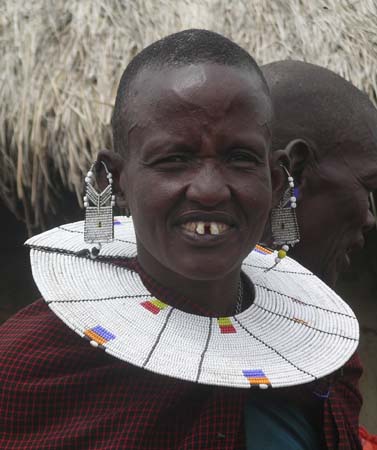 on,
only to return to traditional lifestyles after being unable to find a job.
on,
only to return to traditional lifestyles after being unable to find a job.
After buying some souvenir Maasai jewelry and leaving Justin's family with
some fabric that we had purchased as a gift, we walked through the village
center and settled down for a picnic lunch. A thick fog made it hard to see
everything going on in the village, but we did stop by a small market 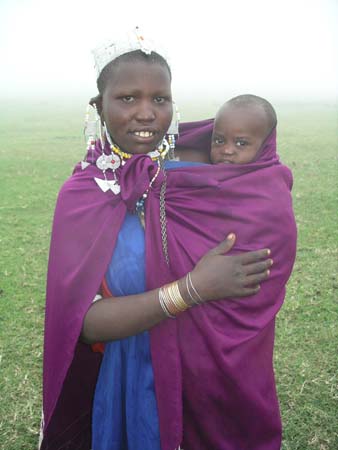 where
women were selling milk and yoghurt. Although we weren't able to take pictures
here, the large group of women in red brought back memories of some of the
colorful markets we had seen in India.
where
women were selling milk and yoghurt. Although we weren't able to take pictures
here, the large group of women in red brought back memories of some of the
colorful markets we had seen in India.
We had to wait for a couple of hours in Naiyobi while the donkeys that were
carrying our duffel bags, tents and camping supplies arrived. A group of seven
donkeys had left Emp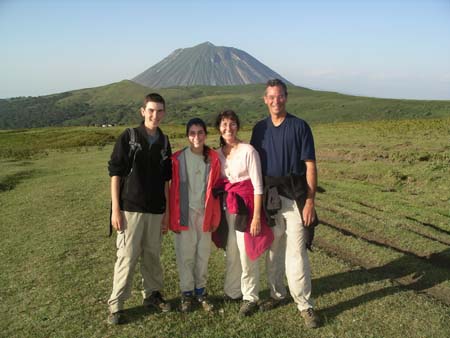 akaai
shortly after we began hiking, but the fog that kept coming in and out of
the trail made it very slow-going for them (apparently the donkeys don't like
fog, and it makes them walk very slowly). To pass the time, we enjoyed learning
a traditional Tanzanian card game until around 4:00PM when the donkeys finally
arrived.
akaai
shortly after we began hiking, but the fog that kept coming in and out of
the trail made it very slow-going for them (apparently the donkeys don't like
fog, and it makes them walk very slowly). To pass the time, we enjoyed learning
a traditional Tanzanian card game until around 4:00PM when the donkeys finally
arrived.
The rest of our hike took us along a ridge with beautiful views of Oldonyo
Lengai directly in front of us. The sun had finally burned its way through
the fog just in time for us to see what was arou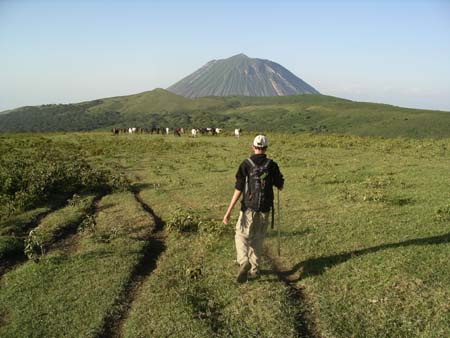 nd
us. We were walking through the highlands in beautiful green grass with great
scenery all around. Along the way, we passed several groups of friendly children
and villagers who were very curious about us and why we were there. Many of
the children ran behind us yelling "Jambo, Jambo! (this is Swahili for
nd
us. We were walking through the highlands in beautiful green grass with great
scenery all around. Along the way, we passed several groups of friendly children
and villagers who were very curious about us and why we were there. Many of
the children ran behind us yelling "Jambo, Jambo! (this is Swahili for
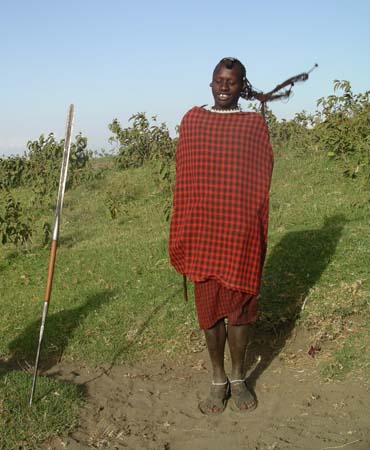 "hello").
One Maasai warrior was having fun doing a traditional dance, and we watched
and laughed as Justin and Nassibu joined in.
"hello").
One Maasai warrior was having fun doing a traditional dance, and we watched
and laughed as Justin and Nassibu joined in.
Our hike continued into a beautiful forest of acacia trees, and we finally
arrived at camp at around 6:00PM. Today's delay because of the fog meant that
the  dedicated
staff that is helping us through our adventure had to set up much of the camp
in the dark. We again were not allowed to help, making us all feel very guilty.
However, they managed to put up our in a very short period of time, serve
us popcorn and drinks, and make a spaghetti dinner. After dinner we were treated
to a very fun display of Maasai singing and dancing, and David (being almost
warrior age!) joined in like a real trooper.
dedicated
staff that is helping us through our adventure had to set up much of the camp
in the dark. We again were not allowed to help, making us all feel very guilty.
However, they managed to put up our in a very short period of time, serve
us popcorn and drinks, and make a spaghetti dinner. After dinner we were treated
to a very fun display of Maasai singing and dancing, and David (being almost
warrior age!) joined in like a real trooper.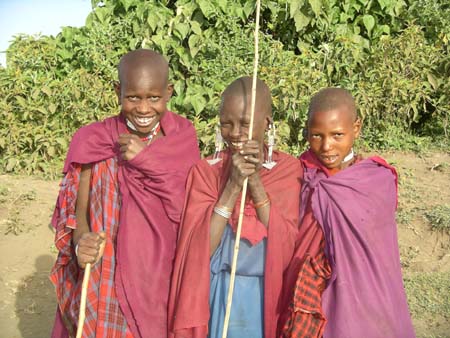
Tomorrow we'll complete our hike through the Rift Valley, and will end up at a campsite near Lake Natron. We plan to explore the lake area, which is home to flamingoes and a variety of wildlife. We'll also spend time visiting the local Maasai village and some homes.
